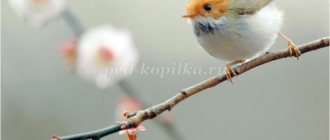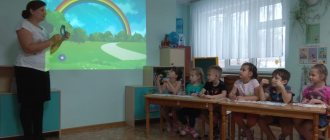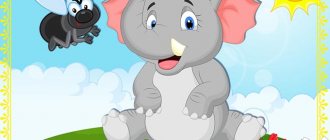Summary of an open lesson in the junior group “Cockerel and his family”
Kirichenko Oksana Vladimirovna
Summary of an open lesson in the junior group “Cockerel and his family”
Expand children's understanding of poultry: chicken, rooster , chickens; continue to learn to distinguish between them.
Continue to introduce children to folklore works that tell about the cockerel , hen, and chickens. Form cognitive activity.
Enrich children's vocabulary with words: hen, cockerel , chickens, chick, pecks, strengthen the ability to imitate the voices of birds.
Develop fine motor skills of the hands and finger coordination through exercises and hand massage with objects.
Cultivate a kind attitude towards “our smaller brothers”
, encourage children's initiative.
Fairy tale. "Cockerel and his family"
Elnara Khanakhmedova
Fairy tale.
“Cockerel and his family” Once upon a time there lived Cockerel and his family . Dad is a Rooster , mom is a Chicken, and the little chickens are brothers and sisters.
All of them were obedient except Pim and Pan. One day the chicken took a bucket and went to the river to get water. And Papa Cockerel went to the poultry market to buy grains. And they told their chickens.
“Stay together, don’t go outside the gate, walk in the yard.”
“Okay, okay,” all the chickens answered in unison. And Pim and Pan immediately forgot their mother’s and father’s words.
"I want too"
-
said Pan .
And the other chickens told .
- Have you forgotten mom and dad’s request? You can’t go out the gate without mom and dad!
“We are not afraid of anything,” said Pym and Pan . Without listening to mom, dad, brothers and sisters, they went to the clearing.
"Let's"
-
said Pan .
- And I'm afraid, Pim. Who is this?
It was a cat. She was looking for mice in the grass. I wanted to eat them.
And the naughty chickens promised never to leave the yard without permission again.
OOD for speech development “Cockerel and his family” in the first junior group of the MBDOU kindergarten “BELOCKA” in the Olkhovatsky municipal district of the Voronezh region. OOD on speech development On the topic: “Cockerel and his family.”
Abstract of the educational activity “Cockerel and his family” Educational activity “Cognitive development” Purpose: To give children a general understanding of poultry (rooster, hen, chickens, etc.).
GCD summary for speech development in the first junior group “Cockerel and his family” GCD summary for speech development in the 1st junior group “Cockerel and his family” Goal: Speech development Objectives: Educational area “Cognitive.
Summary of GCD in the nursery group “Cockerel and his family” Summary of GCD in the junior group on social and communicative development. TOPIC: “Cockerel and his family” Goal: to form the concept of “Family” in children.
Abstract of the educational activity in the junior group on cognitive development “Cockerel and his family” Goal: to form ideas about the family and its members Tasks: to form ideas about the family using the example of the cockerel’s family, to show care.
Abstract of an educational activity on cognitive development in the first group of early age “Cockerel and his family” Synopsis of an integrated educational activity on cognitive development in the first group of early age “Cockerel and his family” Objectives: 1. Expand ideas.
Didactic game “Cockerel and his family” Program content: 1. Teach children to clearly pronounce the sound “K” in onomatopoeia. 2. Contribute to the development of intonation expressiveness.
Source
Cockerel and his family. Lesson in 1st junior group
Summary of a lesson on speech development at a preschool educational institution.
Early age, 2-3 years. This material is intended for young children.
Lesson for speech development. Program objectives:
Educational:
To develop the ability to answer questions and interest in fiction.
Strengthen the ability to distinguish between “big and small” quantities. Learn to pronounce onomatopoeic words with different voice strengths (quiet-loud). Continue teaching children to define quantity using the words “one-many.” Teach children to build a collective building as shown by an adult. Developmental:
Develop the ability to distinguish and name primary colors: red, green, yellow, develop thinking skills.
Develop the ability to listen carefully to a work. Develop speech. Activate the dictionary (one, many). Encourage children to answer questions. Educational:
To cultivate accuracy when doing work.
Cultivate a kind attitude towards animals. Vocabulary : red, yellow, green, poultry yard. Sound pronunciation: ku-ka-re-ku, ko-ko-ko, pi-pi-pi. Preliminary work: introduce children to domestic birds, look at illustrations of birds, talk about domestic birds. Reading poems, stories; learning nursery rhymes, didactic game “Who Screams How.” Material: silhouettes of poultry: cockerel, hen, chickens;
constructor for building a fence. Progress of the lesson:
Children enter the hall and greet the guests.
Educator : Now guys, listen to me carefully. Today we will go to visit the poultry yard. A poultry yard is a place where poultry live. Now I will tell you the fairy tale “A Cockerel with his Family,” and you listen carefully and tell me who this fairy tale is about. Children : About Cockerel. Educator: Well done. Yes, the cockerel lives in the poultry yard. Let's remember which other poultry lives there. Children: Hens, chicks, ducks, geese. Educator: That's right, well done, let's go and see our poultry yard. Game "Collect a flower". Look how handsome he is. Where have we come guys? Children : To the poultry yard. Educator: Correct. Guys, look who is walking in the poultry yard today. Children: Cockerel, hen, chickens. Educator: Guys, look what a beautiful cockerel. What color is the comb? Children: Red. Educator : Correct. And Zlata knows about the cockerel nursery rhyme. Please tell me. Zlata: “Cockerel, cockerel. Give me a comb. Well, please, please. I’ll comb my curls.” Educator: Well done, kids, how does the cockerel sing? Children: “Ku-ka-re-ku” (quietly and loudly). Educator: Let's sing a song. Children sing the song “Caring Chicken”. Educator : Guys, the birds really liked the song. There is a knock on the door. Chicken enters. Educator : Guys, look who came to us? Children : Chicken. Educator : That's right, what a beautiful handkerchief the chicken has. What color is it? Children: Green. Educator: Correct. How does the chicken scream? Children: Ko-ko-ko (quiet-loud). Educator: Well done, let's dance for our chicken. Chicken: Listen to one riddle: “He appeared in a yellow fur coat, goodbye two shells.” Who is this? Children : Chickens. Educator: That's right, look how beautiful they are. What color is their fluff? Children: Yellow. Educator: Correct, but how do they squeak? Children : Pee-pee-pee (quiet-loud). Educator : Guys, what do cockerels, hens and chicks like to eat? Children: Grains, seeds, bread. Educator : Children, today I prepared plates for our birds to eat. One plate is large, red; the other small one is green. Guys, is our cockerel big or small? (big). Educator : What color is the comb? (red) So what kind of plate should we put out for the cockerel to treat? Children : Big, red. Educator : Correct. What color is the chicken's scarf? (green). So let's put a plate? Children: green. Educator: Correct. Guys, what kind of chickens do we have: big or small? (small) What color are the chickens? (yellow) So what should the plate be like? Children : yellow. Educator : Correct. What shape are the plates? Children: Round. Educator : Now we will pour grains into plates and feed the birds. Hen, take a red plate for the cockerel. Children, what color plate did the Chicken take? So, the children place all the plates. Educator : Let our friends peck the grains. The chicken clucks. Educator: Guys, the chicken is calling you and me and wants to tell us something. Chicken: Co-co-co, guys, there’s a hole in the fence in the poultry yard and I’m afraid for my chickens. The fox walks nearby and can climb into the yard. Help ko-ko-ko build a strong fence. Educator: Let the kids help build a strong fence. What will we build from? Children: Made from bricks. Educator : That's right, let's build it. Children and teacher are building a fence. Educator: Well done guys, what a beautiful fence they built, and now the fox won’t get into the poultry yard. Chicken : Ko-ko-ko, thanks kids. I really liked the fence, it is durable. And for your work I want to treat you. Ko-ko-ko, guys, what am I going to bring to you now? Children : Egg. Chicken: Correct. Testicles, but not simple ones, but magical ones. Thank you for your help. Educator: Oh, guys, look, how many candies are there? Children : A lot. Educator: That's right, take one for yourself and say “thank you” to the chicken. Children say “thank you” to the chicken and say goodbye to friends in the poultry yard. Then the children say goodbye to the guests and leave for the group.
We recommend watching:
Speech development in younger preschoolers in kindergarten Summary of a lesson on speech development in the 1st junior group. Poems by Barto Summary of a lesson on speech development in the 2nd junior group Summary of a lesson on speech development in the second junior group using EER
Similar articles:
Lesson notes for the 1st junior group of kindergarten. Introduction to clay
Lesson summary for an early age group. Getting to know the sun
Summary of a game development lesson in kindergarten in the second group of early age on the topic: Animals
Summary of a game lesson for children of the third year of life on the topic: Octopus
Summary of a game lesson for children of the third year of life on the topic: Clocks
Open lesson “Cockerel and his family”
Vasil Yunusov
Open lesson “Cockerel and his family”
— Expand children’s understanding of poultry: chicken, rooster , chickens; continue to learn to distinguish between them.
-Continue to introduce children to folklore works that tell about the cockerel , hen, and chickens. Form cognitive activity.
— Enrich children’s vocabulary with words: hen, cockerel , chickens, chicken, pecks, strengthen the ability to imitate the voices of birds.
— Develop fine motor skills of the hands, finger coordination through exercises and hand massage with objects.
— Cultivate a kind attitude towards poultry, encourage children to take initiative.
Reading nursery rhymes that talk about a cockerel , hen, chickens; looking at story toys. (hen, chickens, cockerel , conversation.
Vocabulary work: cockerel , hen, chickens, ku-ka-re-ku, ko-ko-ko, pi-pi-pi.
Equipment: easel, pictures of a rooster , hen, chickens; audio recording with the sounds of poultry.
Handouts: clothespins, wooden blocks.




